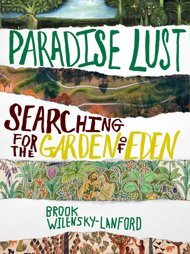Paradise Lust: Searching for the Garden of Eden
By Brook Wilensky-Lanford
(Grove Press)

It’s a challenge: Choose the location for the original Garden of Eden from the 17 suggested by this book’s new map.
In the first two chapters of the book of Genesis, God is quoted as pinpointing the fruitful area where Adam and Eve would live. He names four rivers flowing out of it.
Two of the rivers, the Tigris and the Euphrates, largely in what is now Iraq, are familiar to anyone who has looked at war news in the last decade. They flow side by side, from Turkey in the north, south through Iraq into the Persian Gulf.
The other two rivers ― God calls them the Pishon and the Gihon ― have not been finally identified. They’ve puzzled adventurous minds for centuries, including St. Augustine, Christopher Columbus and Emperor Wilhelm II, who led Germany through World War I.
St. Augustine, an early commentator, had trouble deciding if the garden was a real place, finally concluding that it was. Columbus wrote Ferdinand and Isabella that if the area that impressed him ― now northern Venezuela ― could be conquered, it would help convert pagans to Christianity. The emperor sometimes called “Kaiser Bill” got into trouble with German church people after he helped run a slide show on a controversial theory.
Author Brook Wilensky-Lanford confuses the puzzlement a bit more by calling her survey “Paradise Lust.” This isn’t a sex manual, just wordplay on John Milton’s epic poem, “Paradise Lost.” She clarifies in her subtitle: “Searching for the Garden of Eden” and goes on to describe the persistent ― some might say, passionate ― pursuit over the centuries.
Her witty and exhaustively researched book favors a theory in a 1987 article for the Smithsonian Magazine. It attributes the idea to Juris Zarins, then professor of archaeology at Southwest Missouri State University. She reached him last year.
He sees the Adam and Eve story as a personalized version of prehistoric conflict, largely in southern Iraq.
Prehistoric hunter-gathering peoples depended ― as did Adam and Eve before the serpent came ― on God’s bounty of wild plants and prey they could kill. A new and progressive generation consisted of farmers who devised how to plant their own seeds and choose their own food ― like Adam and Eve, post serpent.
Much later, after writing was invented, the Israelis wrote their version in the book of Genesis.
“To put it simply,” Wilensky-Lanford writes, “God tells humanity: ‘If you think you can do better, go ahead and try; see how you like it.’”
Wilensky-Lanford reached Zarins at his later work in the sultanate of Oman and asked what was so fascinating about the Garden of Eden.
“You tell me,” he replied, “you’re the one calling from halfway around the world!”
(AP)
By Brook Wilensky-Lanford
(Grove Press)

It’s a challenge: Choose the location for the original Garden of Eden from the 17 suggested by this book’s new map.
In the first two chapters of the book of Genesis, God is quoted as pinpointing the fruitful area where Adam and Eve would live. He names four rivers flowing out of it.
Two of the rivers, the Tigris and the Euphrates, largely in what is now Iraq, are familiar to anyone who has looked at war news in the last decade. They flow side by side, from Turkey in the north, south through Iraq into the Persian Gulf.
The other two rivers ― God calls them the Pishon and the Gihon ― have not been finally identified. They’ve puzzled adventurous minds for centuries, including St. Augustine, Christopher Columbus and Emperor Wilhelm II, who led Germany through World War I.
St. Augustine, an early commentator, had trouble deciding if the garden was a real place, finally concluding that it was. Columbus wrote Ferdinand and Isabella that if the area that impressed him ― now northern Venezuela ― could be conquered, it would help convert pagans to Christianity. The emperor sometimes called “Kaiser Bill” got into trouble with German church people after he helped run a slide show on a controversial theory.
Author Brook Wilensky-Lanford confuses the puzzlement a bit more by calling her survey “Paradise Lust.” This isn’t a sex manual, just wordplay on John Milton’s epic poem, “Paradise Lost.” She clarifies in her subtitle: “Searching for the Garden of Eden” and goes on to describe the persistent ― some might say, passionate ― pursuit over the centuries.
Her witty and exhaustively researched book favors a theory in a 1987 article for the Smithsonian Magazine. It attributes the idea to Juris Zarins, then professor of archaeology at Southwest Missouri State University. She reached him last year.
He sees the Adam and Eve story as a personalized version of prehistoric conflict, largely in southern Iraq.
Prehistoric hunter-gathering peoples depended ― as did Adam and Eve before the serpent came ― on God’s bounty of wild plants and prey they could kill. A new and progressive generation consisted of farmers who devised how to plant their own seeds and choose their own food ― like Adam and Eve, post serpent.
Much later, after writing was invented, the Israelis wrote their version in the book of Genesis.
“To put it simply,” Wilensky-Lanford writes, “God tells humanity: ‘If you think you can do better, go ahead and try; see how you like it.’”
Wilensky-Lanford reached Zarins at his later work in the sultanate of Oman and asked what was so fascinating about the Garden of Eden.
“You tell me,” he replied, “you’re the one calling from halfway around the world!”
(AP)









![[Kim Seong-kon] Democracy and the future of South Korea](http://res.heraldm.com/phpwas/restmb_idxmake.php?idx=644&simg=/content/image/2024/04/16/20240416050802_0.jpg&u=)







![[KH Explains] Hyundai's full hybrid edge to pay off amid slow transition to pure EVs](http://res.heraldm.com/phpwas/restmb_idxmake.php?idx=652&simg=/content/image/2024/04/18/20240418050645_0.jpg&u=20240418181020)

![[Today’s K-pop] Zico drops snippet of collaboration with Jennie](http://res.heraldm.com/phpwas/restmb_idxmake.php?idx=642&simg=/content/image/2024/04/18/20240418050702_0.jpg&u=)